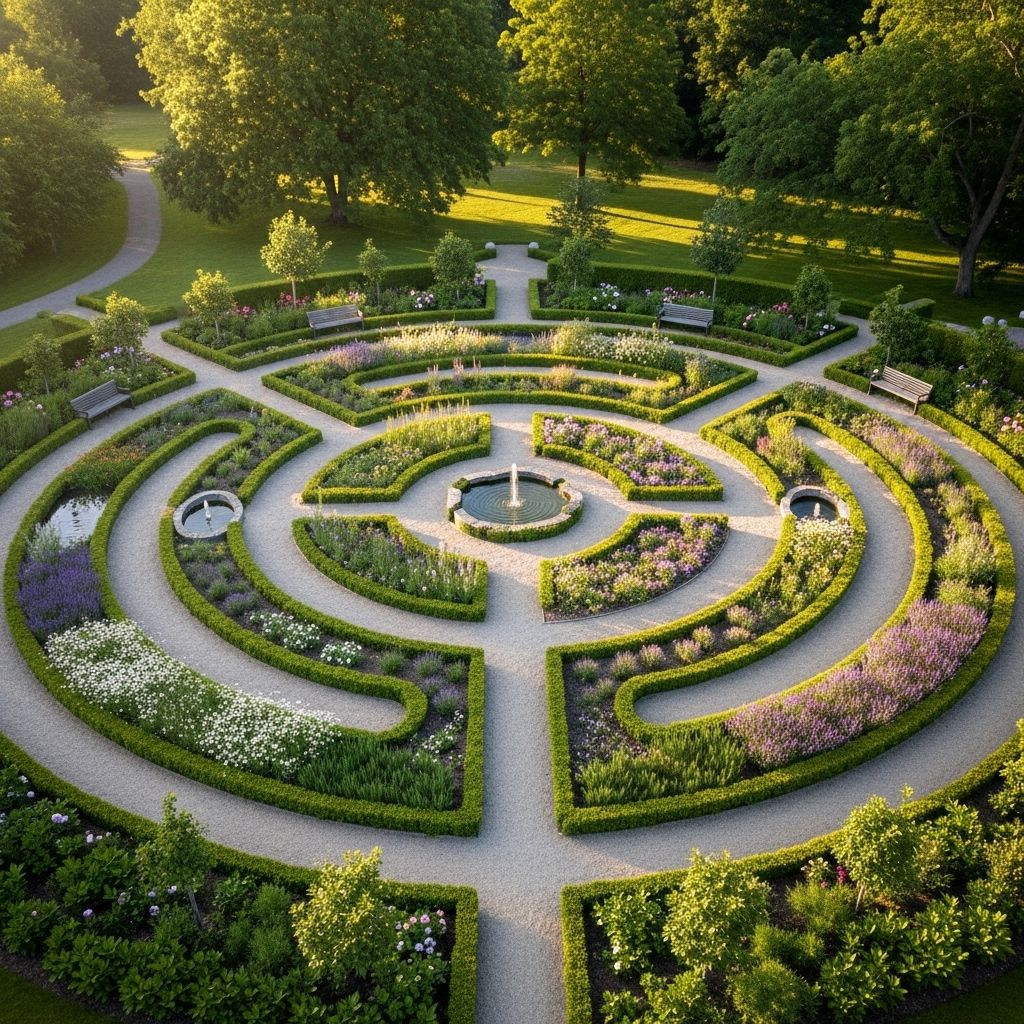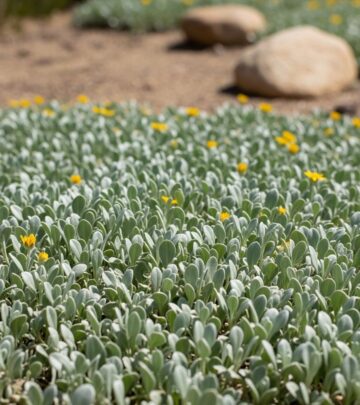Labyrinth Garden Design: Complete Guide To Healing Landscapes
Discover how a thoughtfully crafted labyrinth garden blends artistry, ecology, and healing in landscape design.

Image: HearthJunction Design Team
The Healing Labyrinth Garden: A Sanctuary of Design and Renewal
Labyrinth gardens have long captivated the human imagination, serving as spaces for reflection, healing, and deep connection with nature. The Healing Labyrinth Garden, meticulously crafted by landscape designer Claire Jones, stands as a modern testament to these classical ideals. Situated on a gentle slope, this garden blends structural artistry with ecological wisdom to create a restorative, interactive landscape for its visitors.
Origins and Purpose of the Labyrinth
The inception of the labyrinth garden was rooted in a deeply personal story. Designed to be a place of personal, psychological, and spiritual healing, Claire Jones envisioned more than just a decorative landscape. She sought to create a sanctuary—a place where visitors could slow down, reflect, and reconnect with themselves while surrounded by the beauty and tranquility of nature.
Jones’s approach was equally informed by her understanding of how landscape design can support mental health. She recognized that labyrinths, with their winding paths and contemplative nature, provide a unique environment for mindfulness and gentle meditation.
Addressing the Challenge of the Slope
Unlike traditional flat garden sites, the location chosen for the labyrinth presented a significant challenge: a pronounced hillside. To address this, Jones employed a classic yet robust solution. She constructed a retaining wall using large boulders of Pennsylvania field stone, a technique that required both artistry and engineering. This dry-laid wall followed a gentle curve, subtly embracing the labyrinth area and establishing a sense of enclosure and safety.
Wide, sturdy field stone steps were carefully embedded into the hillside, providing a gracious and accessible descent from the upper garden areas down toward the labyrinth itself. These steps encourage a sense of transition for visitors, marking the journey from the everyday world into the unique contemplative space below.
Meticulous Site Preparation
Creating the labyrinth’s flat surface was a crucial step in the construction process. Claire Jones emphasized the importance of careful groundwork to ensure the lasting stability of the stone paths. The preparation involved:
- Grading the hillside to form a level base.
- Power tamping the soil and gravel to prevent future shifting.
- Installing black landscape cloth to suppress weeds and stabilize the surface.
- Marking the template for precise stone placement, ensuring the labyrinth’s pattern was true to design.
This attention to foundational detail ensured the labyrinth would remain structurally sound and visually pleasing for many years to come.
Selecting Stones and Creating the Path
The heart of any labyrinth is its winding path. Jones selected natural stones, carefully placing each to create a smooth, navigable walkway. The pattern was deliberately designed to invite visitors into a rhythmic, meditative journey toward the center and back out again. The choice of materials and the skill of their arrangement play a crucial role in the labyrinth’s tactile and aesthetic appeal, adding texture and a sense of permanence to the garden.
Bringing Nature Closer: The Pollinator Plantings
In keeping with the healing theme, Claire Jones chose to surround the labyrinth with a diverse selection of pollinator-friendly plants, inspired by the clients’ wish to honor their son’s love of butterflies and ladybugs. As both a landscape designer and an experienced beekeeper, Jones brought deep knowledge to plant selection, ensuring the garden would support local biodiversity year-round.
Designing for Pollinators
- Plants that attract butterflies, bees, and ladybugs.
- Species chosen for their adaptability to sun and shade.
- Inclusion of native and perennial species for long-term sustainability.
- Use of golden and variegated foliage to brighten shaded areas.
- Strategic addition of colorful annuals each spring (like wave petunias, zinnias, and verbena) to provide summer nectar sources.
The result is a vibrant, living border that changes with the seasons, offering continuous habitat for pollinators while enhancing the garden’s sensory richness.
Plant List: Key Selections for Sun and Shade
Jones’s plant palette is notable for both its beauty and ecological function. Here is an example of the kinds of plants that thrive in the Healing Labyrinth Garden:
| Sun-Loving Plants | Shade-Tolerant Plants |
|---|---|
| Lavender (Lavandula) | Hosta (Hosta spp.) |
| Black-eyed Susan (Rudbeckia hirta) | Astilbe (Astilbe spp.) |
| Salvia (Salvia spp.) | Ferns (Polystichum spp.) |
| Verbena (Verbena spp.) | Lungwort (Pulmonaria) |
| Blanket Flower (Gaillardia) | Heuchera (Heuchera spp.) |
These selections ensure that the garden provides habitat, nectar, and visual interest from early spring through late fall.
Design Philosophy: Labyrinths as Healing Spaces
The labyrinth has deep historical and symbolic roots, representing a journey toward the center—both physically and metaphorically. In garden design, this translates to a path that encourages slow movement, contemplation, and an escape from daily stress. The Healing Labyrinth Garden goes a step further by actively engaging the senses: visitors feel the texture of stone underfoot, hear the hum of pollinators, and observe the changing tapestry of color and form throughout the seasons.
This multi-layered experience elevates the garden from a simple landscape feature to a restorative environment, offering psychological and emotional benefits to its users.
Maintaining the Garden: Seasonal Tasks and Care
The maintenance of a labyrinth garden is guided by both aesthetic and ecological priorities. Key seasonal tasks include:
- Spring: Planting annuals, refreshing mulch, dividing perennials as needed.
- Summer: Deadheading spent blooms, monitoring for drought stress, supporting tall plants.
- Autumn: Cutting back perennials and removing annuals, planting bulbs for spring color.
- Winter: Minimal intervention, allowing structure and evergreens to provide interest.
This ongoing care ensures the garden remains vibrant, healthy, and welcoming throughout the year.
Connecting with the Broader Landscape
The labyrinth garden is not an isolated feature; it is designed to harmonize with its surroundings. The curved retaining wall and the flow of stone steps draw the eye and the visitor into the landscape, while the plantings provide ecological connectivity with the broader garden and local habitat. This thoughtful integration fosters a sense of place—an essential element in successful landscape design.
Inspiration from Tradition: Labyrinths in Garden History
Labyrinths have a rich history in Western garden design, dating back to the Renaissance and even earlier. Traditionally, they were crafted as intricate walks lined with dense hedges, designed to both delight and disorient the walker, culminating in a rewarding, ornamented center. The Healing Labyrinth Garden pays homage to this tradition while adapting it for contemporary needs, focusing on accessibility, ecological balance, and spiritual well-being.
The Emotional and Psychological Benefits
- Encourages mindfulness and relaxation.
- Provides a structured space for meditation and personal reflection.
- Supports mental health through regular exposure to nature.
- Offers a symbolic journey, often seen as a metaphor for healing and self-discovery.
The Healing Labyrinth Garden is thus more than a design statement—it is a living, breathing space dedicated to nurturing both its visitors and the local ecosystem.
Frequently Asked Questions (FAQs)
What is the purpose of a labyrinth in a garden?
A labyrinth in a garden serves as a meditative path designed for personal reflection, healing, and spiritual renewal. Walking the winding path helps visitors slow down, focus inward, and reconnect with nature.
How is a labyrinth different from a maze?
Unlike a maze, which has multiple paths and is meant to challenge with choices and dead ends, a labyrinth features a single, continuous path that leads to the center and back out, promoting contemplation rather than confusion.
What makes a pollinator-friendly garden?
A pollinator-friendly garden uses a diverse array of flowering plants that provide nectar, pollen, and habitat for beneficial insects like bees, butterflies, and ladybugs. Such plantings enhance biodiversity and garden health.
Can labyrinth gardens be adapted for small or urban spaces?
Yes. While the Healing Labyrinth Garden is on a larger site, the principles—single-path design, pollinator plantings, and focus on sensory engagement—can be scaled to fit smaller gardens or even rooftop settings.
How do you maintain a labyrinth garden?
The key is regular seasonal care: planting annuals in spring, deadheading flowers in summer, cutting back perennials in autumn, and minimal intervention in winter. Mulching and occasional weeding help keep the paths and beds tidy.
Conclusion: A Living Legacy
The Healing Labyrinth Garden exemplifies the fusion of technical expertise, ecological stewardship, and profound artistry. Through careful design, inspired plant selection, and a commitment to healing, this space continues the long tradition of labyrinths as places of beauty, renewal, and community. Whether as a private sanctuary or a shared public retreat, the labyrinth garden endures as a source of inspiration for those who seek connection—with the land, with others, and with themselves.
References
- https://www.gardendesign.com/baltimore/labyrinth.html
- https://www.tandfonline.com/doi/abs/10.1080/14601176.2017.1386422
- https://naturesacred.org/roof-labyrinth-rendering/
- https://landscapedesignbylee.blogspot.com/2011/10/labyrinth-in-landscape-story-of-prayer.html
- https://heald.nga.gov/mediawiki/index.php/Labyrinth
Read full bio of medha deb












